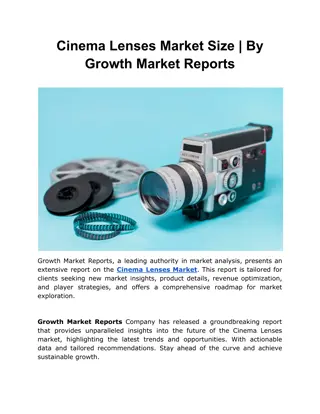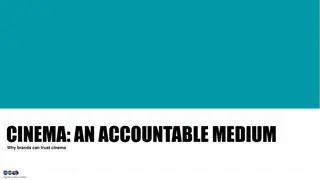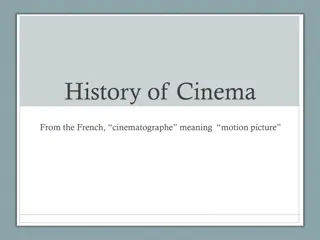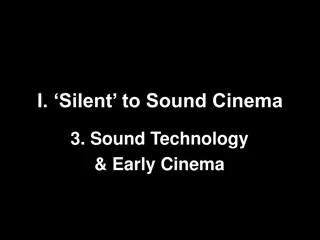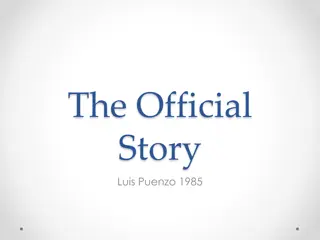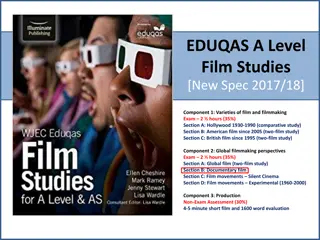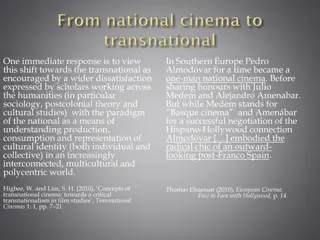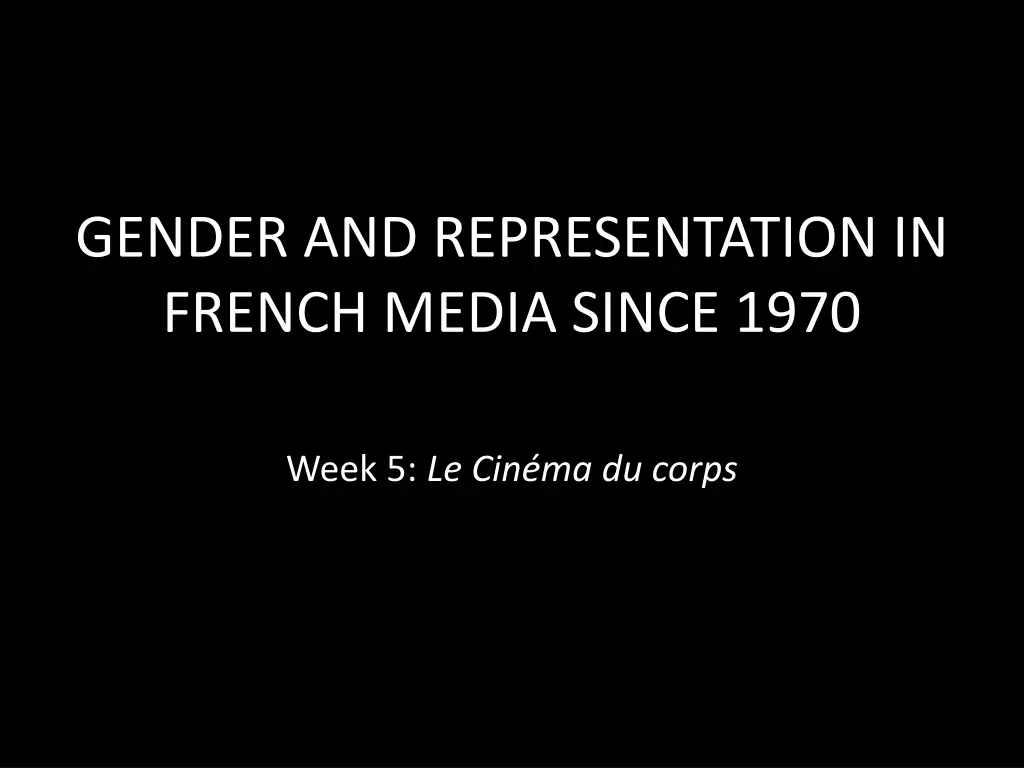
Gender Representation in French Media: The Evolution Since 1970
Explore the transformation of gender representation in French media since 1970, focusing on the cinematic perspective. Delve into the themes of New French Extremism, explicit portrayals of sex and violence, and the academic and mainstream reception of such content. Unpack the historical determinants shaping French literary and cinematic landscapes.
Download Presentation

Please find below an Image/Link to download the presentation.
The content on the website is provided AS IS for your information and personal use only. It may not be sold, licensed, or shared on other websites without obtaining consent from the author. If you encounter any issues during the download, it is possible that the publisher has removed the file from their server.
You are allowed to download the files provided on this website for personal or commercial use, subject to the condition that they are used lawfully. All files are the property of their respective owners.
The content on the website is provided AS IS for your information and personal use only. It may not be sold, licensed, or shared on other websites without obtaining consent from the author.
E N D
Presentation Transcript
GENDER AND REPRESENTATION IN FRENCH MEDIA SINCE 1970 Week 5: Le Cin ma du corps
Structure of the Session Picking up on last week CLIP: 2 Days in Paris (2007) For this week s topic - Introduction to the New Extremism/le cin ma du corps other examples - Breillat in context - Overview of Kristeva reading - Kristeva and film studies (MH) - Overview of Downing and Keesey readings - General discussion of ma soeur! through questions and in relation to the readings
The New French Extremism See J. Quandt on extra reading. From realism to extremism N.B. On realism in cinema see Hallam, J. and M. Marshment. 2000. Realism and Popular Cinema. Manchester: Manchester University Press, especially pp.197-201. Bruno Dumont (La Vie de J sus, L Humanit , Twentynine Palms) Gaspar No (Carne, Seul contre tous, Irr versible) Fran ois Ozon (Sitcom, Les Amants criminels)
Violence (rape, self-mutilation) Irr versible (No 2002) Dans ma peau (Marina de Van, 2002) Demonlover (Olivier Assayas, 2002) Le Vie nouvelle (Philippe Grandrieux, 2002) Sex/pornography Le Pornographe (Bertrand Bonello, 2001) Choses secr tes (Jean-Claude Brisseau, 2002) Pola X (Leos Carax, 1999) Intimacy (Patrice Ch reau)2001)) Elements of both Trouble Every Day (Claire Denis, 2001) (cannibalism) Baise-moi (Virginie Despentes and Coralie [Trinh-Thi], 2000) Cerebral sex Ma m re (Christophe Honor , 2004) (Based on Georges Bataille; necrophilia) Breillat: Romance (1999), A ma soeur! (2001), Sex is Comedy (2002), Anatomy of Hell (2004), Une vieille ma tresse (2007)
Features: Explicit representation of sex and violence Blurring of boundaries (auteur/popular; art cinema/pornography; good/bad taste*) e.g. Une vieille ma tresse (Breillat, 2007) Academic interest: the body, the abject, representation of desire and sexuality Mainstream reception: provocation, moral panic Extremism and the political void (cf. critic No l Burch) An export category* * See M. Selfe, 2010. Incredibly French? Nation as an interpretative context for Extreme Cinema. In L. Mazdon and C. Wheatley (eds), Je t aime...moi non plus: Franco-British Cinematic Relations. New York and Oxford: Berghahn Books, pp.153- 168.
Historical Determinants French Literary: Sade, Dada/Surrealism, Artaud, Bataille, C line, Michel Houellebecq, Catherine Millet, Virginie Despentes N.B. see Maddock and Krisjansen on extra reading re the links to Bataille and surrealist poetics. Cultural valuation of libertinage and seduction Art film: Dada/Surrealism, Godard (Weekend), Blier, Last Tango in Paris (Bertolucci 1972), La Mamain et la putain (Jean Eustache, 1973) Popular cinema: 1970s explosion in soft-core and hard-core porn e.g. the exploitation films of Jean Rollin, Emmanuelle (1974 end of censorship, essentially for pornography) International Increased sexualisation of culture Film genres: horror (torture porn), sexual thriller, rape-revenge films Relationship to politics (the retreat from ideology) Retreat of militant feminism
Catherine Breillat Born 1948 Writer and filmmaker (and actress) First novel, L Homme facile, written at the age of 17 You always have to test yourself to the limit, even at the risk of destroying yourself or others [to Cahiers du cin ma, 1999] Representations Explorations of heterosexual sexuality from a cerebral perspective ( Pas le sexe, la question sexuelle , ma soeur!) Critique of machismo Frequent adoption of female point of view, especially young women Real time sex scenes
Womens Cinema as Art Cinema in France: A Historical Precedent L Les Plages d Agn s (Agn s Varda, 2008) Sex is Comedy (Breillat, 2002)
Alongside a Dialogue with the Male Auteur Canon Subverting gaze structures while exploring the morality of rape
Relation to feminism Refusal of woman director label. Feminists do not love me. My own position is that a woman must be a militant feminist in life, but when she is making a work of art, things are different. [to Monthly Film Bulletin, 1998.] Adoption of male discourse (intellectual, professional) Provocation Libertinage discourse (protest against the regulation of prostitution) see https://mauvaiseherbe.wordpress.com/tag/noel-burch/
Breillat since Ma Soeur! The turn to the past Une vieille ma tresse (2007), , set in nineteenth century; Barbe bleue, 2009, which is more difficult to categorise as extreme. I love Dandyism and the nineteenth century [ ] The novel was written by a man [Barbey d Aurevilly]. I identify myself as a painter. And a painter s signature is his last name. My name is Breillat. We know it s feminine, but that s not because of what you see on the screen. I haven t left provocation behind, but when I made Anatomy of Hell, I said that was the tenth film with a big X; the last, the most hard-core, the one that transgresses every taboo. [ ] Once I got that out of my system, I wanted to make a film about pleasure and passion, something more soothing for the viewer. The thing that interests me is that the two characters exchange qualities as their relationship progresses. Asia [Argento] is masculine and dominates Ryno de Marigny, and sometimes he is the one who dominates her [ ] Source 2007 Cannes Film Festival Press Conference http://www.festival-cannes.com/en/theDailyArticle/55627.html Le Cin ma du corps as a phenonenon of the 2000s? Cf. Abus de faiblesse 2013 more interested in non-sexual power dynamics and seen as more humane in general.
Julia Kristeva 1941- Bulgarian-French academic, philosopher, literary critic, psychoanalyst, sociologist, feminist, and, most recently, novelist. She has lived in France since the mid-1960s. T Probably best known for her work on the abject in Pouvoirs de l horreur. This is not least due to its enormous influence on film studies scholarship focused on the horror genre, notably in the work of Barbara Creed.the University Paris Diderot.
For instance, on Alien: The horror [then] played out can be read in relation to Kristeva s concept of the semiotic chora [ ] Kristeva argues that the maternal body becomes the site of conflicting desires (the semiotic chora). These desires are constantly staged and restaged in the workings of the horror narrative where the subject is left alone, usually in a strange, hostile place, and forced to confront an unnameable terror, the monster. The monster represents both the subject s fears of being alone, of being separate from the mother, and the threat of annihilation often through reincorporation. As oral-sadistic mother, the monster threatens to reabsorb the child she once nurtured. Thus, the monster, like the abject, is ambiguous; it both repels and attracts. Creed, Horror and the Monstrous-Feminine: An Imaginary Abjection. In B. K. Grant (ed.), The Dread of Difference: Gender and the Horror Film (Austin, University of Texas Press, 1996), p. 58. Wider resonances gross- out comedy
ma soeur! Seminar Questions - How can we describe the film's aesthetics? Are they realistic/stylised/expressionistic/symbolic? Think here about the characteristics of its spaces, colour palette and mise-en-sc ne in general. - Where might we find 'abject' sites within the film, using Julia Kristeva's term? What is the force of these from a feminist perspective? - How are the graphic sex scenes filmed, compared with conventional representations, and why? - What is the meaning of the ending?


